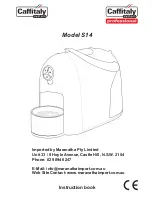
31
30
GB
GB
BAKING PoWDER
Baking powder is used as a rising agent for UL-
TRASCHNELL
(ultra fast)
breads and cakes . It does
not need rise time, and it can produce air . Due to
chemical processes, the air forms bubbles that
soften the texture of the bread .
SoDA
It is similar to baking powder . It can also be used in
combination with baking powder .
WAtER AND otHER lIQuIDS
Water is an essential ingredient for making bread .
Generally speaking, water between 20°C and 25°C
is the best .
The water may be substituted with fresh milk or
water mixed with 2 % milk powder, which may
enhance bread flavour and improve crust colour .
Some recipes may call for juice to enhance the fla-
vour (e . g . apple juice, orange juice, lemon juice) .
EGGS
Eggs can improve bread texture, make the bread
more nourishing and increase the size . The egg
must be cracked open and then stirred evenly .
MEASuRING INGREDIENtS
The most important thing for making good bread
is to use the proper amounts of ingredients . It is
strongly recommended to use measuring cups
(8) or measuring spoons (9) to obtain accurate
amounts . Failure to use accurate amounts can
have a significant influence on the quality of the
bread .
MEASuRING lIQuID INGREDIENtS
Water, fresh milk or milk powder solution should
be measured with measuring cups (8) .
Check the level of the cup with your eyes on a
horizontal plane to the surface of the liquid . When
you measure cooking oil or other ingredients,
clean the measuring cup (8) thoroughly .
DRY MEASuREMENtS
Dry measuring must be done by gently spooning
ingredients into the measuring cup (8) .
When measuring small amounts of dry ingredi-
ents, use measuring spoons (9) .
Measurements must be level and not heaped, as
this small difference could throw off the critical
balance of the recipe .
SEQuENCE oF INGREDIENtS
Generally speaking, the ingredients should be
added as follows:
Liquid ingredient, eggs, salt and milk powder
etc .
When adding the ingredients, do not complete-
ly wet the flour . The yeast can only be placed on
the dry flour . And yeast should not come into
contact with the salt .
After the flour has been kneaded for some time,
a beep will prompt you to put fruit ingredients
into the mixture . If the fruit ingredients are
added too early, the flavour will be diminished
during the long mixing time . When you use the
delay function for a long time, never add perish-
able ingredients (e .g . eggs, fruit) .
Measuring Spoon (9):
Equates to 1 Tablespoon
Equates to 1 Teaspoon
tRouBlESHootING GuIDE
No. Problem
Cause
Solution
1 Smoke from ventilation
hole when baking .
Some ingredients are
sticking to the heater
element or nearby .
For the initial use, oil
remained on the surface
of heat element .
Unplug the bread maker
and clean the heat ele-
ment, but be careful not
to burn you .
During the first use, dry
operating and open the
lid .
2 Bread bottom crust is too
thick .
The warm bread is left in
the pan for too long, and
thereby loses too much
water .
Take bread out quickly,
without using the warm-
ing function .
3 It is very difficult to
remove the bread .
Kneading blades sticking
to the shaft in the bread
pan .
After removing the
bread, put hot water into
bread pan and -immerge
kneading blade for
10 minutes .
Then take it out and
clean
4 Ingredients not evenly
stirred and bake poorly .
Incorrect program selected .
Select the correct program .
Too much resistance, so
kneading blades can’t
rotate and stir adequately .
Check kneading blades
hole; then take bread pan
out and operate without
the pans .
If not normal, contact an
authorized service facility .
5 The bread ends up dry,
with no brown crust colour .
The cover was opened
several times during opera-
tion .
Don’t open cover during
operation – especially during
the final rise .
6 Display “H HH” after press-
ing the START / STOPP
(start / stop)
button .
The temperature in the
bread maker is too high to
make bread .
Press START / STOPP
(start
/ -stop)
and unplug bread
maker .
Then, remove bread pan
and open cover until the
bread maker cools down .
















































